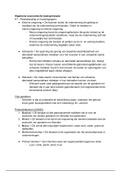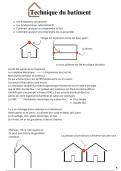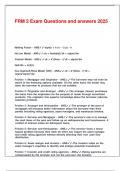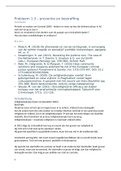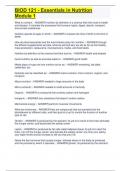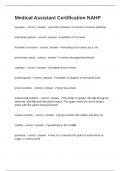Samuel Nesbitt
This topic includes:
1- Definitions of abnormality
2- Phobias
3- Explanations for phobias – Behavioural
4- Treatment for phobias – Behavioural
5- Depression
6- Explanations for depression – Cognitive
7- Treatment for depression – Cognitive
8- OCD
9- Explanations for OCD – Biological
10- Treatment for OCD – Biological
,Psychology Year 1 & AS Psychopathology Samuel Nesbitt
1-Defintions of abnormality
Defining abnormality I
Statistical deviation - occurs when an individual has a less common characteristic e.g. more
depressed or less intelligent than most of the population.
Deviation from social norms - concerns behaviour that is different from the accepted standards
of behaviour in a community or society.
Statistical infrequency:
Defining abnormality in terms of statistics.
o Measuring whether something is ‘normal’ or ‘abnormal’ is in terms of the number of
times it is observed.
Behaviour that is rarely seen is abnormal.
o Any relatively ‘usual’ or often seen, behaviour can be thought of as normal.
o Any behaviour that is different, or rare, is ‘abnormal.’
A statistical infrequency.
Example: IQ and intellectual disability disorder.
o IQ is normally distributed (see right)
o The average IQ is 100. Most people have an IQ between
85 and 115, only 2% have a score below 70.
o Those below 70 are statistically unusual or ‘abnormal’
They are diagnosed with intellectual disability disorder.
Limitation 1 – People may not benefit from a label.
1. No benefit to label someone who is happy and living fulfilled life.
o E.g - low IQ – not distressed and capable of working – doesn’t need a diagnosis of
intellectual disability.
o Being stigmatised with ‘abnormal’ may have negative effects on the way others view
them and the way they see themselves.
2. However - psychiatric practice, they will only be diagnosed with a mental disorder if they fail
to function adequately.
Limitation 2 – unusual characteristics can be positive.
1. Not all cases of unusual behaviour need treatment or a diagnosis.
o IQ scores over 130 are just as unusual as those below 70.
2. Equally, there are some normal behaviours that are undesirable.
o E.g. Depression is common but undesirable.
2
, Psychology Year 1 & AS Psychopathology Samuel Nesbitt
Deviation from social norms
Abnormality is based on social context.
o When a person behaves in a way that is different from how they are expected to
behave they may be defined as abnormal.
o Societies and social groups make collective judgements about ‘correct’ behaviours in
particular circumstances.
Definitions are related to cultural context.
o Historical differences within the same society.
E.g., homosexuality is viewed as abnormal in some cultures but not others and
was considered abnormal in our society in the past.
Example: Antisocial personality disorder. (Psychopathy)
o Failure to conform to ‘lawful and culturally normative ethical behaviour” – DSM-V
A psychopath is abnormal because they deviate from our moral standard.
(usually lacking empathy)
Limitation 1 – Culturally relative.
1. A person from one cultural group may label someone from another group as abnormal using
their standards
o E.g. hearing voices is socially acceptable in some cultures but seen as abnormal in the
UK.
o This creates problems for people from one culture living within another cultural group.
E.g. high rate of black Caribbean males - diagnosed with schizophrenia in UK
but are normal in their own country.
2. Therefore, in practice there are no universal standards for labelling a behaviour as abnormal.
Limitation 2 – Human rights abuses.
1. History shows sometimes definitions of abnormality are used to control minority ethnic
groups and women.
o Nymphomania – women attracted to working-class men
Systematic abuse of human rights and way of gaining social control.
o What is socially acceptable changes over time – e.g. homosexuality – DSM-2
2. Therefore, it can be argued that abnormal classifications are abuses of people’s right to be
different.
3
This topic includes:
1- Definitions of abnormality
2- Phobias
3- Explanations for phobias – Behavioural
4- Treatment for phobias – Behavioural
5- Depression
6- Explanations for depression – Cognitive
7- Treatment for depression – Cognitive
8- OCD
9- Explanations for OCD – Biological
10- Treatment for OCD – Biological
,Psychology Year 1 & AS Psychopathology Samuel Nesbitt
1-Defintions of abnormality
Defining abnormality I
Statistical deviation - occurs when an individual has a less common characteristic e.g. more
depressed or less intelligent than most of the population.
Deviation from social norms - concerns behaviour that is different from the accepted standards
of behaviour in a community or society.
Statistical infrequency:
Defining abnormality in terms of statistics.
o Measuring whether something is ‘normal’ or ‘abnormal’ is in terms of the number of
times it is observed.
Behaviour that is rarely seen is abnormal.
o Any relatively ‘usual’ or often seen, behaviour can be thought of as normal.
o Any behaviour that is different, or rare, is ‘abnormal.’
A statistical infrequency.
Example: IQ and intellectual disability disorder.
o IQ is normally distributed (see right)
o The average IQ is 100. Most people have an IQ between
85 and 115, only 2% have a score below 70.
o Those below 70 are statistically unusual or ‘abnormal’
They are diagnosed with intellectual disability disorder.
Limitation 1 – People may not benefit from a label.
1. No benefit to label someone who is happy and living fulfilled life.
o E.g - low IQ – not distressed and capable of working – doesn’t need a diagnosis of
intellectual disability.
o Being stigmatised with ‘abnormal’ may have negative effects on the way others view
them and the way they see themselves.
2. However - psychiatric practice, they will only be diagnosed with a mental disorder if they fail
to function adequately.
Limitation 2 – unusual characteristics can be positive.
1. Not all cases of unusual behaviour need treatment or a diagnosis.
o IQ scores over 130 are just as unusual as those below 70.
2. Equally, there are some normal behaviours that are undesirable.
o E.g. Depression is common but undesirable.
2
, Psychology Year 1 & AS Psychopathology Samuel Nesbitt
Deviation from social norms
Abnormality is based on social context.
o When a person behaves in a way that is different from how they are expected to
behave they may be defined as abnormal.
o Societies and social groups make collective judgements about ‘correct’ behaviours in
particular circumstances.
Definitions are related to cultural context.
o Historical differences within the same society.
E.g., homosexuality is viewed as abnormal in some cultures but not others and
was considered abnormal in our society in the past.
Example: Antisocial personality disorder. (Psychopathy)
o Failure to conform to ‘lawful and culturally normative ethical behaviour” – DSM-V
A psychopath is abnormal because they deviate from our moral standard.
(usually lacking empathy)
Limitation 1 – Culturally relative.
1. A person from one cultural group may label someone from another group as abnormal using
their standards
o E.g. hearing voices is socially acceptable in some cultures but seen as abnormal in the
UK.
o This creates problems for people from one culture living within another cultural group.
E.g. high rate of black Caribbean males - diagnosed with schizophrenia in UK
but are normal in their own country.
2. Therefore, in practice there are no universal standards for labelling a behaviour as abnormal.
Limitation 2 – Human rights abuses.
1. History shows sometimes definitions of abnormality are used to control minority ethnic
groups and women.
o Nymphomania – women attracted to working-class men
Systematic abuse of human rights and way of gaining social control.
o What is socially acceptable changes over time – e.g. homosexuality – DSM-2
2. Therefore, it can be argued that abnormal classifications are abuses of people’s right to be
different.
3


